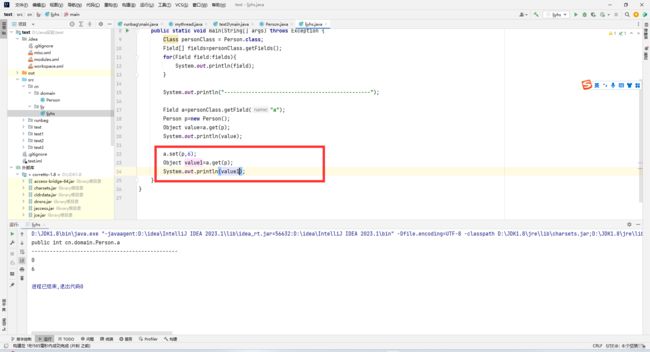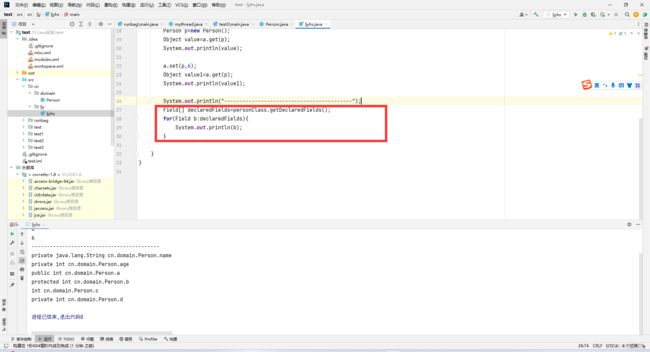JAVAWEB笔记
学的是黑马程序员JavaWeb全套基础教程,java web从入门到项目实战(IDEA版javaweb)
链接
反射
获取Class对象的方式:
1.Class.forName
2和3
package cn.ljy;
import cn.domain.Person;
public class ljyhs {
public static void main(String[] args) throws Exception {
//1.
Class cls=Class.forName("cn.domain.Person");
System.out.println(cls);
// 2.
Class cls2= Person.class;
System.out.println(cls2);
//3.
Person p=new Person();
Class cls3=p.getClass();
System.out.println(cls3);
}
}
输出:
用==去判断它们是否为同一个Class
![]()
Class对象功能:
演示:
1.获取成员变量们
注意:
这里只有a 的修饰符为public,所以只有a输出
那我们如何获取a的值呢?
我们可以用如下方法:
因为我们还没给a赋值,所以a的值为0
我们怎么设置a 的值呢/
这个是不看修饰符的,把所有的成员变量输出
这样我们是不是可以对私有成员变量进行赋值呢?
答案的可以的
让我这个南航第一帅来演示一下:
d.setAccessible(true);//设置访问权限
这个是关键,我们没有这个的话会报错
2.获取构造方法们
3
4
JavaWeb课程介绍
数据库的基本概念
JDBC
快速入门:
mysql数据库软件
图形化界面工具sqlyog
现在我们就可以来学习真正jdbc了
先给一段代码来看看:
public class Main {
public static void main(String[] args) throws Exception {
Class.forName("com.mysql.jdbc.Driver");
Connection conn = DriverManager.getConnection("jdbc:mysql://localhost:3306/ljy","root","root");
String sql="update dept set loc='sc' where id=1";
Statement stmt=conn.createStatement();
int count=stmt.executeUpdate(sql);
System.out.println(count);
stmt.close();
conn.close();
}
}数据库的信息被修改了
1.DriverManager
练习:
向dept里添加数据
package org.example;
import java.sql.Connection;
import java.sql.DriverManager;
import java.sql.SQLException;
import java.sql.Statement;
public class text1 {
public static void main(String[] args) {
Connection conn=null;
Statement stat=null;
try {
//注册驱动
Class.forName("com.mysql.jdbc.Driver");
//定义sql
String str="insert into dept values(2,'cxk','bj')";
//获取Connection对象
conn= DriverManager.getConnection("jdbc:mysql://localhost:3306/ljy","root","root");
//获取sql的对象Statement
stat=conn.createStatement();
//执行sql
int count = stat.executeUpdate(str);//受影响的句子个数
} catch (ClassNotFoundException e) {
throw new RuntimeException(e);
} catch (SQLException e) {
throw new RuntimeException(e);
}finally {
if(stat!=null){
try {
stat.close();
} catch (SQLException e) {
throw new RuntimeException(e);
}
}
if(conn!=null){
try {
conn.close();
} catch (SQLException e) {
throw new RuntimeException(e);
}
}
}
}
}
Resultset :结果集对象,封装查询结果
例如:
package org.example;
import java.sql.*;
public class text2 {
public static void main(String[] args) {
Connection conn=null;
Statement stat=null;
ResultSet rs=null;
try {
//注册驱动
Class.forName("com.mysql.jdbc.Driver");
//定义sql
String str="select * from dept";
//获取Connection对象
conn= DriverManager.getConnection("jdbc:mysql://localhost:3306/ljy","root","root");
//获取sql的对象Statement
stat=conn.createStatement();
//执行sql
rs=stat.executeQuery(str);
//处理结果
rs.next();//移动游标
int id= rs.getInt(1);
String name= rs.getString(2);
String loc= rs.getString("loc");
System.out.println(id+"---------"+name+"---------"+loc);
} catch (ClassNotFoundException e) {
throw new RuntimeException(e);
} catch (SQLException e) {
throw new RuntimeException(e);
}finally {
if(stat!=null){
try {
stat.close();
} catch (SQLException e) {
throw new RuntimeException(e);
}
}
if(rs!=null){
try {
rs.close();
} catch (SQLException e) {
throw new RuntimeException(e);
}
}
if(conn!=null){
try {
conn.close();
} catch (SQLException e) {
throw new RuntimeException(e);
}
}
}
}
}
那如果我们要获取整张表的数据的话,我们应该怎么做呢?
我们没法知道有多少条数据,所以直接手动用next() 不太现实,所以这里我们就要想起循环了。
注:![]()
我们可以这样改进代码:
没有问题!!!
例题:
![]()
解答如下:
package ljy;
public class domain {
private int id;
private String name;
private String loc;
public int getId() {
return id;
}
public void setId(int id) {
this.id = id;
}
public String getName() {
return name;
}
public void setName(String name) {
this.name = name;
}
public String getLoc() {
return loc;
}
public void setLoc(String loc) {
this.loc = loc;
}
@Override
public String toString() {
return "domain{" +
"id=" + id +
", name='" + name + '\'' +
", loc='" + loc + '\'' +
'}';
}
}
package org.example;
import com.mysql.jdbc.Driver;
import ljy.domain;
import java.sql.*;
import java.util.ArrayList;
import java.util.List;
public class text3 {
public static void main(String[] args) {
List list= new text3().findAll();
System.out.println(list);
}
public List findAll(){
Connection conn=null;
Statement sta=null;
ResultSet res=null;
List list=null;
try {
Class.forName("com.mysql.jdbc.Driver");
conn= DriverManager.getConnection("jdbc:mysql:///ljy","root","root");
String sql="select * from dept";
sta= conn.createStatement();
res=sta.executeQuery(sql);
list=new ArrayList();
while (res.next()) {
int id = res.getInt(1);
String name = res.getString(2);
String loc = res.getString("loc");
domain d=new domain();
d.setId(id);
d.setLoc(loc);
d.setName(name);
list.add(d);
}
} catch (ClassNotFoundException e) {
throw new RuntimeException(e);
} catch (SQLException e) {
throw new RuntimeException(e);
}finally {
{
if(sta!=null){
try {
sta.close();
} catch (SQLException e) {
throw new RuntimeException(e);
}
}
if(res!=null){
try {
res.close();
} catch (SQLException e) {
throw new RuntimeException(e);
}
}
if(conn!=null){
try {
conn.close();
} catch (SQLException e) {
throw new RuntimeException(e);
}
}
}
}
return list;
}
}
![]()
jdbc工具类:
为了简化代码

























